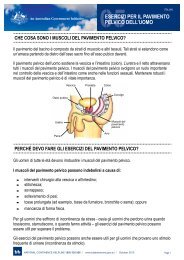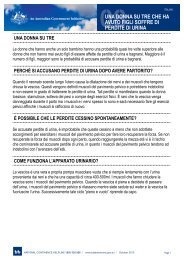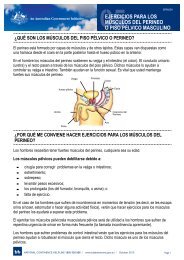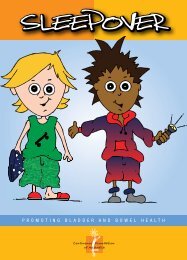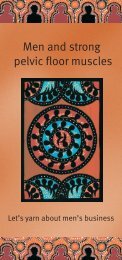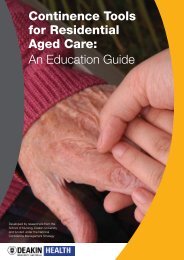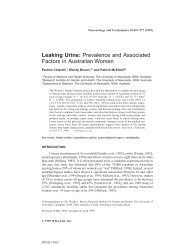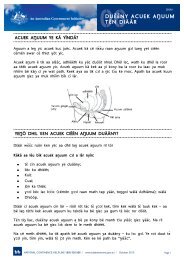Pharmacy Continence Care - Bladder and Bowel Website
Pharmacy Continence Care - Bladder and Bowel Website
Pharmacy Continence Care - Bladder and Bowel Website
Create successful ePaper yourself
Turn your PDF publications into a flip-book with our unique Google optimized e-Paper software.
Use <strong>and</strong> experience of the pharmacy <strong>and</strong> other health care professionals<br />
On average, about half the consumer respondents reported visiting a pharmacy between<br />
once or twice a month (48 per cent vs. 57 per cent) <strong>and</strong> around one third reported at least<br />
once or twice a week (32 per cent vs. 27 per cent). Those visiting less than once a month<br />
(18 per cent vs. 13 per cent) or several times a week (2 per cent vs. three per cent) were<br />
less prominent.<br />
Baseline survey results indicate that seven in 10 (68 per cent) respondents reported having<br />
visited or been visited by a health care professional, such as a GP or community nurse, for a<br />
health check or health treatment in the last three months. This compares with significantly<br />
less (40 per cent) reporting having visited or been visited by a health care professional since<br />
speaking to their pharmacist about incontinence in the follow-up survey.<br />
Of those visiting a health care professional, 59 per cent (16 people) of those in the baseline<br />
survey asked them for advice about incontinence, compared with 92 per cent (11 people) in<br />
the follow-up survey. This information was helpful to 87 per cent (14 people) in the baseline<br />
survey <strong>and</strong> 91 per cent (10 people) in the follow-up survey – more particularly, around half<br />
of those surveyed in each of the two surveys reported the advice as being greatly helpful (50<br />
per cent vs. 45 per cent).<br />
Recall of the type of information received from pharmacies mainly included:<br />
• brochure/pamphlet (63 per cent in both surveys)<br />
• advice about medicines to help (20 per cent in baseline vs. 13 per cent in follow-up)<br />
• advice about exercise, diet or other self-help approaches (up significantly from 10 per<br />
cent to 30 per cent)<br />
• advice about seeing my doctor or a continence service (10 per cent vs. 23 per cent)<br />
• sample of a product (mentioned only in follow-up survey by 23 per cent).<br />
Of those not asking for advice, the main reason was because it was not necessary/managing<br />
problem successfully (50 per cent; six people). Other reasons included lack of time (8 per<br />
cent; one person) <strong>and</strong> not willing to discuss/ too personal (8 per cent; one person).<br />
Consumer feelings were mixed when responding to whether or not they will now use or<br />
continue to use a health professional for more help with incontinence. In the baseline<br />
survey, 43 per cent (19 people) said yes, compared with 53 per cent (16 people) in the<br />
follow-up survey. GPs were the most preferred professional mentioned, particularly in the<br />
follow-up survey (up significantly from 53 per cent to 88 per cent). Other preferred<br />
professionals included: continence nurse (47 per cent vs. 31 per cent), continence clinic (32<br />
per cent vs. 13 per cent) <strong>and</strong> physiotherapist (5 per cent vs. 6 per cent).<br />
Of those saying no to wanting to use a health professional for more help with incontinence<br />
(41 per cent; 18 people vs. 33 per cent; 10 people), the main reasons were around the<br />
following:<br />
• not necessary/managing problem successfully (39 per cent in baseline vs. 40 per cent in<br />
follow-up)<br />
• problem is not bad enough – age factor/only occurs when sneezing/doing exercise (only<br />
mentioned in follow-up survey by 40 per cent)<br />
• embarrassed/would prefer to check with the pharmacist or physiotherapist (only<br />
mentioned in follow-up survey by 40 per cent)<br />
• have already discussed problem with specialist/chemist (only mentioned in baseline<br />
survey by 22 per cent)<br />
Final Report<br />
43<br />
NOVA Public Policy<br />
<strong>Pharmacy</strong> <strong>Continence</strong> <strong>Care</strong> Project



